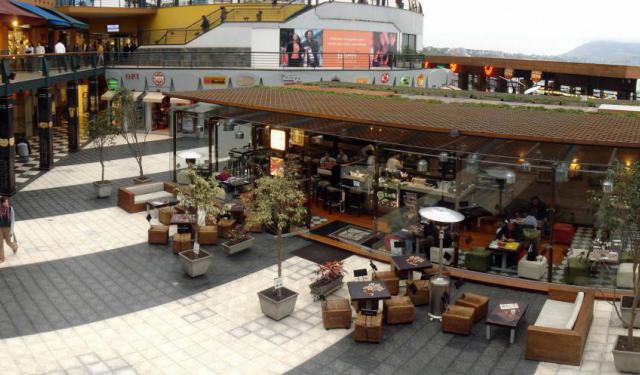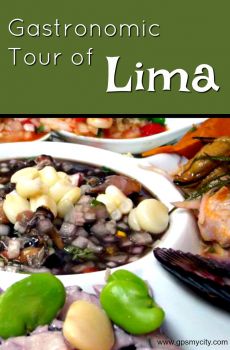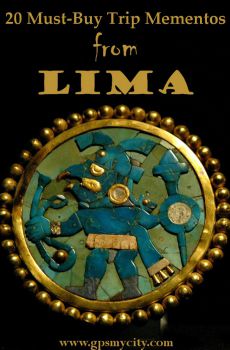
Landmarks of Central Lima, Lima, Peru (A)
Most of central Lima's landmarks are neatly fixed along a corridor running between the Plaza de Armas in the north and the Parque de la Cultura in the south. Beautiful public spaces about in this city of over eight million people, ranging from majestic municipal buildings to comfortable plazas.
How it works: The full article is featured in the app "GPSmyCity: Walks in 1K+ Cities" on Apple App Store and Google Play Store. Download the app to your mobile device to read the article offline and create a self-guided walking tour to visit the sights featured in this article. The app's navigation functions guide you from one sight to the next. The app works offline, so no data plan is needed when traveling abroad.
Sights Featured in This Article
Guide Name: Landmarks of Central Lima
Guide Location: Peru » Lima
Guide Type: Self-guided Walking Tour (Article (A))
# of Attractions: 11
Tour Duration: 4.0 Hour(s)
Travel Distance: 5.6 Km or 3.5 Miles
Author: Jim Reynoldson
Author Bio: Jim Reynoldson is an avid traveler and writer who grew up in Oregon. He enjoys hiking, camping, and sightseeing throughout the Pacific Northwest and beyond.
Sight(s) Featured in This Guide:
Guide Location: Peru » Lima
Guide Type: Self-guided Walking Tour (Article (A))
# of Attractions: 11
Tour Duration: 4.0 Hour(s)
Travel Distance: 5.6 Km or 3.5 Miles
Author: Jim Reynoldson
Author Bio: Jim Reynoldson is an avid traveler and writer who grew up in Oregon. He enjoys hiking, camping, and sightseeing throughout the Pacific Northwest and beyond.
Sight(s) Featured in This Guide:
- Plaza Bolivar
- Palacio Arzobispal
- Plaza de Armas
- Palacio de Gobierno
- Casa de Oquendo
- Casa de Riva-Aguero
- Plaza San Martin
- Palacio de Justicia
- Parque de la Cultura
- Estadio Nacional
- Parque de la Reserva
1

1) Plaza Bolivar
This plaza is of great historic and political importance to Peru. The Legislative Palace – the seat of Peru’s Congress – is located here, and the site also served as the former Tribunal of the Inquisition. The Museo de la Inquisicion is located right across from this plaza – which is also referred to as the Plaza of Congress or the Plaza of the Inquisition. At the center of the plaza is a statue and monument honoring Simon Bolivar – who, along with Jose de San Martin, fought to liberate South America from Spanish rule in the early 19th century and served as president of the union of newly-independent Latin American nations from 1819 to 1830.
2) Palacio Arzobispal
Situated right on the Plaza de Armas in central Lima next to La Catedral on land donated by Francisco Pizarro, construction on this neo-colonial palace began just after the formation of Lima in 1535 to function as a monument to the power of the Catholic Church leadership in Latin America as well as the residence of Lima’s Archbishop. Materials including mahogany, bronze, marble, granite, cedar, and tiles from Seville were shipped from abroad to complete the original structure – and the palace was renovated in 1924. Opened to the public in 2009, this palace displays a wonderful collection of religious art, antique furniture, and a cathedral archive.
Image Courtesy of Manuel González Olaechea y Franco.
3

3) Plaza de Armas
This gorgeous plaza is the historical center of Lima, as well as a busy public space. The conquistador Francisco Pizarro as the first building block of the city of Lima designated the site in 1535, and the ornate fountain functioning as the Plaza’s centerpiece was added in 1651. The plaza served many functions during the colonial period – including a bull fighting ring, a location for gallows, a market, one of the sites on which the Spanish Inquisition occurred, and the official site for the proclamation of Peru’s independence in 1821. A number of important city structures surround the plaza – including La Catedral and the Government palace – and the entire scene is beautifully lit up at night amid the hustle and bustle of tourists and locals alike.
4) Palacio de Gobierno
The headquarters of Peru’s executive branch of government and residence of the President of the Republic of Peru, this palace occupies a prime location overlooking the Plaza de Armas. Francisco Pizarro built the first version of this palace in 1536, and the current building dates back to 1938 – as the site has suffered six major earthquakes during its inception and a fire in 1921. Designed by the architect Ricardo de la Jara Malachowsky, the current building is fashioned in the neo-baroque style. A number of armed guards are on vigilant duty in front of the palace – which can be toured with an advanced reservation with the Office of Public Relations.
Image Courtesy of S2RD2.
5

5) Casa de Oquendo
Built in 1807 by the successful banker, merchant, and ship owner Don Martin de Osambela, this colonial mansion sits just a couple of blocks from the Plaza de Armas in central Lima. The building was designed in the French Rococo style, and the interior contains 40 rooms, as well as a third-story lookout tower above, from where the owner could see ships arriving at the Callao Harbor. The mansion was declared a national monument in 1963, was restored in the 1980’s, and today houses the Garcilaso de la Vega Cultural Center - which is free and open to the public.
6

6) Casa de Riva-Aguero
One of Lima’s iconic colonial mansions, the Casa de Riva-Aguero contains a staggering 27 rooms, balconies, and a beautiful courtyard. Located across from the Iglesia de San Augustin and just a couple of blocks from the Plaza de Armas, the mansion houses a small folk-art museum opened in 1979, with tours of the rest of the house shown by appointment only. Built in the late 18th century and last owned by the writer Don Jose de la Riva Aguero, the house was donated to the Catholic University and contains a library of over 60,000 works as well as a historical archive.
7

7) Plaza San Martin
Located between the Plaza de Armas and the Parque de la Cultura, the Plaza San Martin was inaugurated on July 27, 1921 to celebrate the centennial of Peru’s independence. Designed by Manuel Piqueras Cotoli, the plaza contains marble benches and handrails, bronze street lamps, four fountains, and an array of landscaped gardens. The large monument in the center of the plaza pays tribute to Jose de San Martin, who – along with Simon Bolivar – fought to liberate South America from Spanish rule. The plaza is surrounded by a number of historic colonial buildings – and the entire area was declared a UNESCO World Heritage Site in 1988.
8) Palacio de Justicia
Built in 1947 and standing on the site of a former prison, this striking building was designed by the architect Bruno Paprocki and modeled after the Palace of Justice in Brussels. Set in a position overlooking the Paseo de Republica and the Parque de la Cultura, the huge neoclassical columns create an impressive façade at this seat of Peru’s Supreme Court of the Republic. Two huge marble lions guard the main stairway, and the Great Hall includes more columns and huge bronze lamps. While the Palacio de Justicia is not open to the general public, it is certainly worth seeing and snapping a few photographs.
Image Courtesy of And2000.
9

9) Parque de la Cultura
This gated, centrally located park was originally established in 1868 as the Parque de la Exposicion. Re-inaugurated in 2010 as the Parque de la Cultura by President Alan Garcia, the ceremony included the unveiling of a bust paying tribute to the late political leader Luis Alberto Sanchez. Lush green lawns and trees surround a collection of fountains and buildings showing off Victorian architecture. Art is a primary focus, with many outdoor art shows – and the park houses the Museo de Arte de Lima and the Museo de Arte Italiano. An amphitheater within the park houses a number of concerts and other events free to the public.
10) Estadio Nacional
This multi-use national stadium in central Lima was originally constructed in 1952 to host the 1953 South American Football (soccer) Championship, and began being renovated in 2009 – with a planned seating capacity of 55,000. A project costing over $53 million and expected to open in May of 2011, the new version of the stadium will include the addition of 371 luxury boxes, more than 700 new underground parking spaces, and a tower with a gourmet restaurant with panoramic views of the city. While soccer is its primary function, the stadium also includes an Olympic running track, and has hosted a number of concert events.
Image Courtesy of Phil Whitehouse.
11) Parque de la Reserva
The Parque le la Reserva was built in 1929 and occupies a central location between Central Lima and the Miraflores district. The park houses a number of sculptures and works by Peruvian artists. City leaders added the “Magic Water Tour” in 2007, which is the largest collection of fountains in the world, at a cost of about $13 million (US). Lit up at night with an assortment of changing colors and shapes, the fountains serve as a foundation for a number of multimedia events featuring music, laser lights, and video images in addition to the water displays – many of which offer the visitor the opportunity to walk through tunnels formed by the fountains. To end this tour, simply take a taxi or bus north to the Plaza de Armas or south to Miraflores.
Image Courtesy of Martin Garcia.
Walking Tours in Lima, Peru
Create Your Own Walk in Lima
Creating your own self-guided walk in Lima is easy and fun. Choose the city attractions that you want to see and a walk route map will be created just for you. You can even set your hotel as the start point of the walk.
Miraflores Walking Tour
The district of Miraflores is one of Lima's key tourist destinations, renowned for its affluent setting, upscale shopping, phenomenal oceanic views, seashore restaurants, parks, and interesting archaeological sites. The attractions here are numerous and include, among others, the following:
La Huaca Pucllana – an archaeological complex, featuring a clay pyramid made of seven staggered... view more
Tour Duration: 2 Hour(s)
Travel Distance: 3.4 Km or 2.1 Miles
La Huaca Pucllana – an archaeological complex, featuring a clay pyramid made of seven staggered... view more
Tour Duration: 2 Hour(s)
Travel Distance: 3.4 Km or 2.1 Miles
Lima Introduction Walking Tour
Lima, the capital of Peru, is a huge, thriving metropolis and one of South America’s largest cities; it was established by Spanish conquistador Francisco Pizarro in 1535. The carefully preserved city center has retained much of its original colonial character set in the stones of Plaza de Armas – the city's main square, as well as numerous Baroque and Renaissance cathedrals, colonial... view more
Tour Duration: 2 Hour(s)
Travel Distance: 1.9 Km or 1.2 Miles
Tour Duration: 2 Hour(s)
Travel Distance: 1.9 Km or 1.2 Miles
Food and Shopping Walk
Today's Lima is a large, commerce-booming and tourist-friendly capital, equally rich in terms of ancient culture as well as intricate cuisine and wealth of shopping opportunities suitable for various budgets.
Although in recent years many international brands have found their way to Lima’s stores, the majority of tourists keep looking to street fairs and artisan “Indian” markets... view more
Tour Duration: 2 Hour(s)
Travel Distance: 3.3 Km or 2.1 Miles
Although in recent years many international brands have found their way to Lima’s stores, the majority of tourists keep looking to street fairs and artisan “Indian” markets... view more
Tour Duration: 2 Hour(s)
Travel Distance: 3.3 Km or 2.1 Miles
Useful Travel Guides for Planning Your Trip
Gastronomic Tour of Lima
Peruvian cuisine reflects a rich cultural and geographical diversity. During half a millennium of fusion, flavors from Europe, Africa, and Asia have mingled with Incan fare. Perú’s approximately 90 microclimates produce a startling repertoire of ingredients, many unique to Peruvian soil. A...
20 Must-Buy Trip Mementos from Lima
Today's Peru is a basket of natural, cultural and historical riches manifested in the multitude of handicrafts that have flourished in the country for thousands of years and embraced Inca, Spanish and other influences. Local jewelry, wool, pottery, leather, music, food and drinks - all have a...
The Most Popular Cities
/ view all










